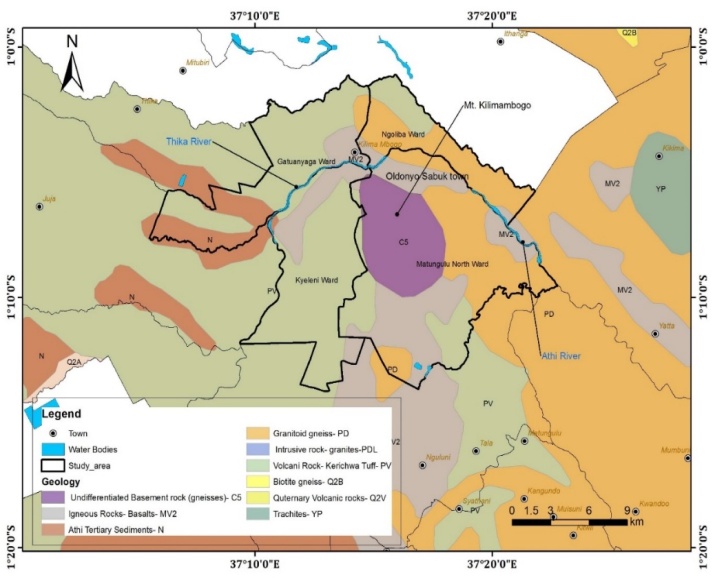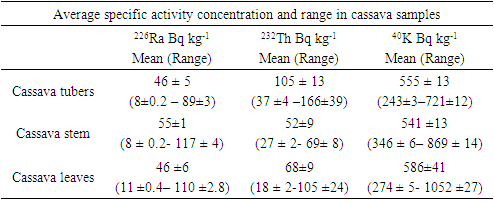-
Paper Information
- Paper Submission
-
Journal Information
- About This Journal
- Editorial Board
- Current Issue
- Archive
- Author Guidelines
- Contact Us
Food and Public Health
p-ISSN: 2162-9412 e-ISSN: 2162-8440
2024; 14(1): 25-27
doi:10.5923/j.fph.20241401.02
Received: Dec. 12, 2023; Accepted: Jan. 5, 2024; Published: Jan. 10, 2024

Radiological Health Assessment of Cassava Samples from Farms in Kilimambogo, Kenya
C. Nyambura1, N. O. Hashim1, M. W. Chege1, S. Tokonami2
1Physics Department, Kenyatta University, Nairobi, Kenya
2Insititute of Radiation Emergency Medicine, Hirosaki University, 66-1 Hon-Cho, Hirosaki, Aomori, Japan
Correspondence to: C. Nyambura, Physics Department, Kenyatta University, Nairobi, Kenya.
| Email: |  |
Copyright © 2024 The Author(s). Published by Scientific & Academic Publishing.
This work is licensed under the Creative Commons Attribution International License (CC BY).
http://creativecommons.org/licenses/by/4.0/

The levels of naturally occurring radionuclides present in the environment vary from place to place depending on their geology. 226Ra, 232Th and 40K in the environment easily get into the food crops through root uptake from the soil and finally through ingestion of either food crops or water. The distributions of the radionuclides in the soil or the plants depends on the chemical properties of the radionuclides and the type of the soil. The distribution of primordial radionuclides in cassava tubers, stem and leaves from Kilimambogo region in Kenya was measured using a Thallium activated Sodium Iodide, NaI (TI) gamma spectrometry technique. The mean activity concentrations of 226Ra, in tubers, stem and leaves were 46 ± 5 Bq kg-1, 55 ± 1 Bq kg-1 and 46 ± 6 Bq kg-1, those of 232Th were 105 ± 13 Bq kg-1, 52 ± 9 Bq kg-1 and 68 ± 9 Bq kg-1 while those of 40K were 555 ± 13 Bq kg-1, 541 ± 13 Bq kg-1 and 586 ± 41 Bq kg-1 respectively. These exceeded the world average values of 33 Bq kg-1, 45 Bq kg-1 and 420 Bq kg-1 for 226Ra, 232Th and 40K. The mean annual effective dose received from the consumption of cassava tubers and leaves were 1.82 ± 0.60 mSv y-1 and 0.81 ± 0.30 mSv y-1 and recording a total dose of 2.63 ± 0.7 mSv y-1 from the consumption of the cassava crop by the residents. This was more than eight-fold higher than the world average ingestion dose of 0.3 mSv y-1 reported by the Canadian Nuclear Safety Commission, (2020). Therefore, ingestion of cassava in the region contributes significantly to the ingestion dose received by the residents. Residents could be advised to reduce the intake cassava tubers and leaves in order to reduce the exposure risk.
Keywords: Radionuclides, Cassava, Doses, Risk
Cite this paper: C. Nyambura, N. O. Hashim, M. W. Chege, S. Tokonami, Radiological Health Assessment of Cassava Samples from Farms in Kilimambogo, Kenya, Food and Public Health, Vol. 14 No. 1, 2024, pp. 25-27. doi: 10.5923/j.fph.20241401.02.
Article Outline
1. Introduction
- Consumption of food products by man is the most important cause of exposure to radionuclides through ingestion pathway since it results to internal radiation doses [1,2]. The absorption of 226Ra, 232Th and 40K by plants depends on the activity concentration of the elements in soil and their characteristics, the bioavailability of the minerals in the soil, root structure and the shoot system [3]. Each radionuclide present in soil may be transported to plants in solution form or get bound to the soil particles. The extent of accumulation of the radionuclides in crops is also influenced by the metal-selective functions of the crops during the metal uptake to sustain the mechanism of homeostasis in the environment [4]. Their rate of absorption by the plant is determined by the concentration of exchangeable calcium present in the soil. Measurements of the radionuclides in food crops help determine the level of risks and harmful effects likely to be received by the general public. The uptake of radium, thorium and potassium by plants depends on the physical, chemical and biological conditions of the soil as well as the chemical properties of the radionuclides [1]. Thorium generally has a lower mobility from soil to plants compared to radium which is more soluble in water hence absorbed more easily through water uptake. Thorium on the other hand has a low solubility and its ions are more bound on the soil, hence low transportation. Radium also portrays characteristics which are similar to calcium and magnesium. The crops get contaminated by the radionuclides either through the root uptake or directly by aerial deposition of fallout on plants. The consumption of radionuclides by the residents may not cause immediate health hazards but may do so in future due to accumulation in body tissues with time. The bioaccumulation of radium and thorium in the plants is influenced by the soil pH. Acidic soils (with low pH) have been reported to enhance availability of radium and thorium. Many researchers have studied the concentration levels in various types of crops and determined the effective doses received as a result of consumption of the crops. There is however little or no available data of the same parameter studied in Kenya. The purpose of this research therefore was to determine the activity concentration of 226Ra, 232Th and 40K in cassava samples and determine the doses received by the residents in Kilimambogo region as a result of consumption of the radionuclides in cassava crop.
2. Materials and Methods
2.1. Sampling
- The sampling points were chosen along the slopes and the environs of Mt. Kilimambogo, Kenya by random sampling technique. The longitudes and latitudes of the sampling points were located using a portable GPS (Global Positioning System) [5]. Figure 1 shows the map of the study region.
 | Figure 1. A Map showing the study area |
2.2. Sample Preparation
- The outer skin of the cassava tubers was peeled off, washed clean and cut into small pieces. The cassava stems were also washed and cut into small pieces. These together with the leaves were sun dried to a constant weight and then ground into powder. They were then dried in an oven at 110°C for 24 hours to completely remove the moisture. Samples were then put in clean and dry plastic containers, weighed, hermetically sealed and stored for approximately 30 days. This was to ensure that radioactive equilibrium between 226Ra, 232Th and their daughter radionuclides was reached [6], and that, radon and thoron gases did not escape from the samples.
2.3. Sample Analysis
2.3.1. Activity Concentration
- A NaI (Tl) scintillation detector was used to determine the activity concentration of the samples. It uses the principle of emission of light by a scintillator material when struck by any form of radiation. It has a scintillator, a photocathode, a photomultiplier tube and the associated electronics. The activity concentration of the cassava samples was determined using equation (1) [7,8].
 | (1) |
 is peak efficiency at the given energy of interest, Pγ is the photon emission probability and Ms mass of sample in kilograms.
is peak efficiency at the given energy of interest, Pγ is the photon emission probability and Ms mass of sample in kilograms.2.3.2. Internal Exposure Due to Consumption of Cassava Crop
- In order to determine the risk imposed by the radionuclides present in the crop on the health of the public, equation (2) was used to determine the doses received by the residents;
 | (2) |
3. Results and Discussion
3.1. Activity Concentrations of 226Ra, 232Th and 40K
- Table 1 summarizes the mean and range of 226Ra, 232Th and 40K concentrations in cassava tubers, stem and leaves sampled from the entire Kilimambogo region. The mean activity concentrations of 226Ra, 232Th and 40K in the samples were 46 ± 5 Bq kg-1, 105 ± 13 Bq kg-1 and 555 ± 13 Bq kg-1 in the tubers, 55 ± 1 Bq kg-1, 52 ± 9 Bq kg-1 and 543 ± 13 Bq kg-1 in the stem and 46 ± 6 Bq kg-1, 68 ± 9 Bq kg-1 and 586 ± 41 Bq kg-1 in the leaves.
|
3.2. Internal Exposure Due to Consumption of Cassava
- The average annual effective dose received by Kilimambogo residents as a result of intake of radionuclides contained in cassava tubers and leaves was also estimated and summarized in Table 2. The annual consumption of the tubers and leaves per individual was estimated to be 90 kg and 25 kg respectively [6]. The mean annual effective dose received from the consumption of the radionuclides in the tubers was 1.82 ± 0.6 mSv y-1, ranging from 0.9 ± 0.3 to 2.8 ± 0.8 mSv y-1, while that received from the consumption of the radionuclides in the leaves was estimated to be 0.81 ± 0.30 mSv y-1 and ranging from 0.4 ± 0.2 mSv y-1 to 1.32 ± 0.7 mSv y-1. This gives a total exposure of 2.63 ± 0.7 mSv y-1. This was lower than the annual doses received by the residents in Mrima hill of 2.4 and 3.8 mSv y-1 in tubers and leaves respectively, (Chege, 2014). Lower doses were also reported in Osun State, Nigeria of 0.66 µSv y-1 [11]. An effective dose of 1.23 ± 0.09 mSv y-1 was reported in Volta region, Ghana as a result of consumption of cassava crop. The results reported in the current study were however higher than the world average dose of 0.12 mSv y-1, and higher than the generic intervention exemption level of 1 mSv y-1 for individual annual dose from radionuclides in major food commodities [12] by a magnitude of 3.
|
4. Conclusions
- The distribution of 226Ra, 232Th and 40K in cassava tubers, stem and leaves samples from Kilimambogo region in Kenya were measured using a Thallium doped Sodium Iodide NaI (TI) gamma spectrometry technique. The mean total annual effective dose received from the consumption of cassava tubers and leaves was measured to be 2.6 ± 0.7 mSv y-1. This was more than eight-fold higher than the world average ingestion dose of 0.3 mSv y-1. As a result, ingestion of cassava contributes significantly to the ingestion dose received by the residents. Residents need to reduce intake of cassava to reduce the exposure risk.
ACKNOWLEDGEMENTS
- The authors are grateful to African Development Bank for supporting this study.
 Abstract
Abstract Reference
Reference Full-Text PDF
Full-Text PDF Full-text HTML
Full-text HTML
